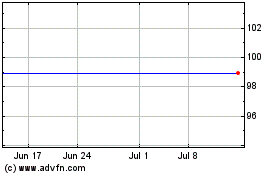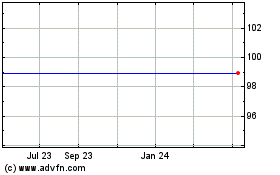When Vice Media made its first foray into basic cable nearly a
decade ago, with programming on MTV2, its scrappy documentaries on
topics like rotting islands of ocean garbage sent advertisers
fleeing.
Now, a more mature—and far more valuable—Vice Media is set to
become the first digital-media company to launch its own cable-TV
channel, a joint venture with A+E Networks, and marketers appear to
have forgiven any past sins.
The network, Viceland, goes live Monday, and has drawn a roster
of major advertisers with its promise of a young audience and of
reinventing a traditional TV-ad model that's increasingly out of
fashion.
Unilever PLC, Bank of America Corp., Smirnoff maker Diageo PLC,
watch and apparel maker Shinola, Bushmills whiskey, Mailchimp,
Samsung Electronics Co., T-Mobile US Inc. and Toyota Motor Corp.
have signed on to the network, which has pledged to carry only
about half of the 18 minutes of ads that most cable networks air in
an hour of programming.
Within a year, Viceland is aiming for roughly half its
advertising inventory to be made up of "native" ads—ads packaged to
look like editorial content and keep audiences from tuning out.
Often made by Vice itself, these spots will frequently be longer
than a typical 30-second ad and will be tailored specifically for
the network, whose other owner, A+E, is jointly owned by Walt
Disney Co. and Hearst Corp.
"We are trying to displace the clutter by injecting some
humanity and authenticity," said Eddy Moretti, co-president of
Viceland and Vice's chief creative officer. "If we create a user
experience that is more engaging than what else is on the dial,
people won't flip."
Vice, which was valued last fall at nearly $4.5 billion in a
recent funding round, isn't alone in identifying that the barrage
of traditional ads that appear on most cable channels are a turnoff
for viewers, particularly younger ones who have grown up with
Netflix, DVRs and ad-blocking software.
Time Warner Inc.'s Turner Broadcasting has begun testing 50%
lighter ad loads on its truTV and TNT networks, while launching a
program of native ads to encourage brands to bring or create their
own content that might stretch across the whole commercial break.
Viacom Inc., which owns youth-focused channels like MTV, Comedy
Central and Nickelodeon, had been carrying particularly heavy ad
loads, but has reduced those across its portfolio by about a minute
per hour over the past year, according to the company.
"Consumers are basically stating that the experience needs to be
a little bit better," said Donna Speciale, president of ad sales
for Turner Broadcasting. "We are taking it very seriously."
Vice arrived at its strategy from its experience in digital
media, where brands have long experimented with native ads. While
such ads are "a little bit more expensive" than traditional
advertising, the price difference is "not egregious," said Andrew
Creighton, Vice's president. A typical 30-second spot on cable TV
costs about $15 per thousand views, according to research firm
SQAD.
Skeptics wonder whether Vice's model has much growth potential,
given not every advertiser can pull off these projects. "It remains
to be seen whether you can gain critical mass to support an entire
network this way," said Chris Geraci, president of national
broadcast at media buyer Omnicom Media Group.
Moreover, it is a challenging time to be launching a cable
network, with pay TV cord-cutting on the rise and all
channels—especially small ones—facing the prospect of brutal
carriage fee negotiations in coming years with big cable and
satellite distributors.
So far, most of Vice's ad partners are still in the early stages
of planning how to do business with Vice. Bank of America Corp. had
previously sponsored the Vice News Web series "Business of Life,"
which covered topics like why college was so expensive. Bank of
America, which supplied relevant content on financial literacy that
runs adjacent to the shows, will be bringing the series to Viceland
in a few months.
One custom ad on Viceland paid for by Unilever will feature a
Vice employee talking about a digital-ad campaign she came up with
for the company's TRESemmé hair-product brand.
Another one, paid for by e-mail-marketing service MailChimp,
will feature a Vice employee interviewing a local business owner
and MailChimp user in Brooklyn's Williamsburg section, just down
the street from Vice's headquarters.
Those ads will run across Viceland's prime-time lineup, which
includes shows like "Weediquette," "Gaycation" and "F*ck, That's
Delicious." They were produced by a new segment of the company, a
30-person unit called Vice Labs.
Anne Finucane, vice chairman of Bank of America, isn't expecting
big ratings from Viceland right off the bat. "For new networks
starting out, I'm not sure that we can expect high ratings," she
said. "The value of this is multiplatform."
The channel has asked measurement specialist Nielsen—and Nielsen
has agreed—to refrain from making its ratings public for the first
six months to allow it to experiment outside the glare of media
scrutiny.
(END) Dow Jones Newswires
February 28, 2016 20:45 ET (01:45 GMT)
Copyright (c) 2016 Dow Jones & Company, Inc.
Time Warner (NYSE:TWX)
Historical Stock Chart
From Mar 2024 to Apr 2024

Time Warner (NYSE:TWX)
Historical Stock Chart
From Apr 2023 to Apr 2024
